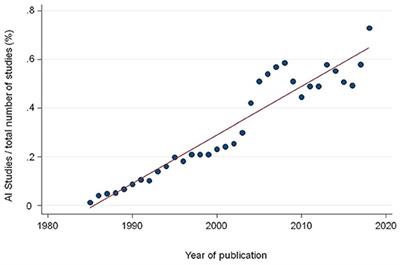AI or statistics, personalised medicine and more
1 - AI or statistics: what is the right terminology and domain of application?
Should we use artifical inteligence (AI) or statistics? Are they even different? In the opinion article below, the authors show distinctions and the need of an unified language to further improve applications of AI in medicine.

Frontiers | Artificial Intelligence and Statistics: Just the Old Wine in New Wineskins? | Digital Health
We are witnessing a tremendous increase in scientific studies using Artificial Intelligence (AI) and in particular Machine Learning (ML) methods in the medical literature. A recent systematic review comparing the classification performance of healthcare professionals vs. AI retrieved over 20,000 records of study reports published since January 2012. In 2020 alone, over 7,000 new records were found in medical electronic databases. 1 Simply by searching the Medline database using the Medical Subject Heading (MeSH) “Artificial Intelligence”, which was introduced in 1986, we find a continued increase of records over the last two decades (Figure 1). The total number of records currently indexed with the term adds up to 120,000 in Medline alone. Several issues beside the sheer number become apparent when reading through those papers.The general readership of medical journals, including clinicians, researchers, statisticians and methodologists have experienced confusion with some of the terms they encounter in papers on AI. Table 1 shows a collection of terms found in the statistics world and its typical counterparts in the machine learning / AI field. [2][3][4] A lack of consensus regarding terminology makes the comparability of studies and study results difficult, or even impossible. For example, in medical applications, diagnostic accuracy is usually reported using statistics as sensitivity, specificity and area under the receiver operating characteristic curve. Studies using …
2 - A new coefficient of correlation
There are two main ways to calculate a correlation, but they either measure linearity or monotonicity between the variables. The coefficient described in the paper below extends this to other types of dependencies between two variables using a simple rank measure.
[1909.10140] A new coefficient of correlation
Is it possible to define a coefficient of correlation which is (a) as simple as the classical coefficients like Pearson’s correlation or Spearman’s correlation, and yet (b) consistently estimates some simple and interpretable measure of the degree of dependence between the variables, which is 0 if and only if the variables are independent and 1 if and only if one is a measurable function of the other, and (c) has a simple asymptotic theory under the hypothesis of independence, like the classical coefficients? This article answers this question in the affirmative, by producing such a coefficient. No assumptions are needed on the distributions of the variables. There are several coefficients in the literature that converge to 0 if and only if the variables are independent, but none that satisfy any of the other properties mentioned above.
3 - Personalised medicine
Current technologies allow us to provide better care for patients in a case by case basis. Stephen Senn discusses the role of variation in personalised medicine. He argues that we need to understand all sources of variation before one can say that statistical heterogeneity leads to a patient specific effect and vice-versa.
https://onlinelibrary.wiley.com/doi/full/10.1002/sim.67394 - Inferring causal GRNs with single cell RNA-seq
Gene regulatory networks (GRNs) are a way to describe the relationship between genes. In the paper below the authors describe a new method to infer causal GRNs using single cell RNA-seq data.
https://www.sciencedirect.com/science/article/pii/S24054712203003635 - Uncertainty in science communication
Should we only communicate point estimates? Are confidence intervals even necessary in communication? In the talk below, Jessica Hullman speaks to the President’s Council of Advisors on Science and Technology at White House about the necessity of uncertainty when communicating scientific results. She also points out how certitude is harmful for society and how we should bring uncertainty when communicating scientific results. Her talk starts at 3:13:23 and ends at 3:30:30.

PCAST: Detecting, Tracking, Mitigating, and Preventing Wildfires and Improving Science Communication - YouTube
On March 24, 2022, the President’s Council of Advisors on Science and Technology (PCAST) will meet to discuss detecting, tracking, mitigating, and preventing…
6 - Bonus (!): Turning ggplot2 into supermarket receipts
Ever wondered if you could plot your beautiful images using a receipt machine found in a supermarket? Your problems are over! In the post below the author describes the process of converting a ggplot2 object such that one can use the receipt machines to print it!
